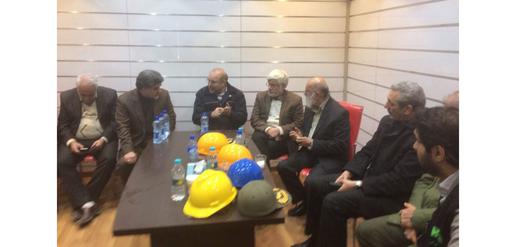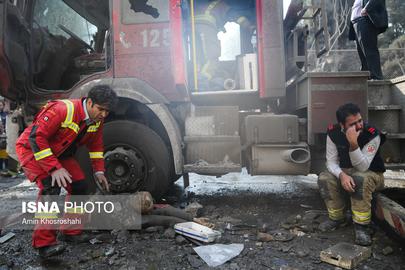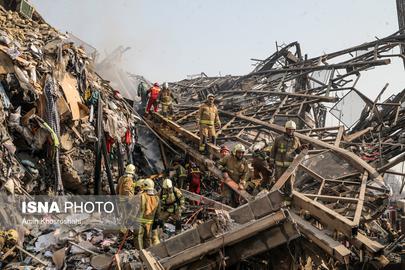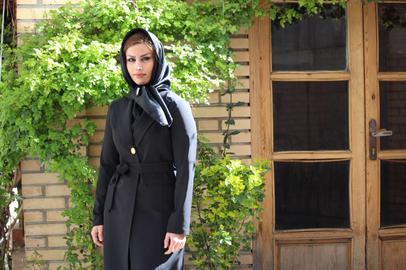A high-rise building in Tehran collapsed early on Thursday, January 19, killing at least 30 firefighters and injuring some 75 people. The collapse happened minutes after a massive fire spread through the building. International media, including the Associated Press, reported on the disaster, quoting Iranian state media.
Almost immediately, groups of Iranians went on Twitter to call for the resignation of Tehran’s mayor, Mohammad Bagher Ghalibaf, using the hashtag #Ghalibaf_Resign ((قالیباف_استعفا in Persian).
The 17-storey Plasco Building was built in the early 1960s by the Iranian Jewish businessman Habib Elghanian, who named it after his plastics manufacturing company. At the time of its construction, it was the tallest building in the capital. After the 1979 Revolution, Elghanian was executed by the “Hanging Judge” Sadegh Khalkhali on charges including espionage. The government confiscated the Plasco Building, and it was subsequently turned into a major apparel manufacturing, distribution and shopping center.
Iranian military sent units to help with today’s disaster, state television reported, and Mayor Ghalibaf, who had been in the city of Qom at the time, rushed to the scene to personally oversee rescue operations.
For many Iranians, the fire was a reminder of a fatal fire in 2013, when two female garment workers lost their lives. Many people taking part in the Twitter campaign asaid that if that incident had been taken seriously, then today we would not have witnessed the Plasco Building disaster and the loss of so many lives.
In the autumn of 2013, a dressmaking workshop in Tehran’s Republic Avenue caught fire, soon escalating out of control. Two workers — Nasrin Foroutani, 44, and Azar Haghnazari, 60 — threw themselves out of the windows in an attempt to escape and died. Firefighters were present at the scene, but reportedly did nothing to save the women. Talking to the media afterward, the families of the victims repeatedly complained that the officials responsible had blamed the victims instead of apologizing.
God’s Will?
At the time of the 2013 fire, Mojtaba Abdollahi, deputy-mayor for municipal services, attributed the death to “God’s will.” But the incident also led to a debate about the unchecked wear and tear of firefighting equipment in Tehran. Omid Bani Salimi, the dealer for the German manufacturer of firefighting trucks Magirus GmbH used by Tehran’s Fire Department said the department had prevented his company from periodic inspections of trucks that had been sold to the municipality. “They had used substandard parts to maintain the equipment,” he said, adding that Tehran Municipality owed his company more than $130,000 for the inspections. To avoid incurring further costs, they simply stopped ordering any more inspections. His claim was later corroborated by a member of Tehran City Council.
It took Mayor Ghalibaf two months after that fire to apologize to the families of the two victims. Many officials criticized the fire department’s performance, and some people called for Ghalibaf to be impeached. A number of City Council members also asked for his resignation. “Our social obligation as city managers is to give the citizens a sense of security,” said Ahmad Masjed Jamei, the City Council President at the time. “To do that we must act with sensitivity and follow up on such incidents.” Mohammad Sarkhou, a member of the council, asked: “Shouldn’t the mayor resign to soothe the feelings of the citizens? Shouldn’t legal action be taken against the wrongdoers?”
“Political Vengeance”
But hardliner media dismissed these protests and statements, labeling them acts of “political vengeance and claiming that reformist members of the City Council wanted to get rid of Ghalibaf to achieve their own political ends.
After Ghalibaf finally apologized, the controversy was somewhat quelled. He also conceded that firefighting services were essential to the lives of citizens and they must be improved and modernized.
But now, three years later, a landmark building in Tehran has been destroyed and many people — including firefighters — have lost their lives. According to available statistics, out of the 30 major metropolitan centers in the world, Tehran is sixth in the world when it comes to the number of fires reported in the city. It follows New York, London, Vienna, Madrid and Paris. According to the head of Iran’s City Council’s Safety Commission, Tehran’s Fire Department has to fight 300 fires on average every day.
Despite this, Rahmatollah Hafezi, a member of the City Council, has reported that out of a council budget of more than 140 billion tomans, or more than $43 million, the Fire Department received only $25 billion.
Many people tweeting about the tragedy pointed out pointed out that Tehran’s firefighting equipment is in bad shape and that the safety measures for old buildings in Tehran, and across Iran, are woefully inadequate. They also suggested that instead of focusing on showy projects and buildings, to prevent a repeat of Plasco Building disaster, the municipality must do more to make older buildings safe.
Some on Twitter said that considerable money is spent on billboards across Tehran, but “it seems that nobody cares about rebuilding.” Others pointed out that it was the duty of the municipality to keep people safe and implement safety measures in buildings.
In September 2016, the Tehran City Council passed bylaws to improve safety and firefighting services for the city. According to Article 2 of these bylaws, Tehran Municipality must regularly inspect buildings and public places for fire hazards and must take necessary actions to oblige property owners to meet fire safety standards.
According to Masoumeh Abad, a member of City Council, buildings are ranked on how much of a fire hazard they pose. Those that are deemed to have a high risk factor must be inspected once a year; middle-ranking buildings are to be inspected once every three years; and lower-risk buildings should be examined once every 10 years.
It Could Happen Again
A Tehran Fire Department spokesperson said that the owners of the Plasco Building had been warned repeatedly, but they had ignored the warnings. Today’s tweets mention that another high-rise building near Plasco Building suffers from similar problems, and another disaster might be on the way.
Just as happened in the aftermath of the 2013, some Ghalibaf supporters immediately reacted to calls for his resignation by labeling it “political vengeance.” They also published videos of him directing rescue operations at the site. A “crisis management center” has been set up by President Rouhani’s First Vice President Eshagh Jahangiri.
It is unlikely that appeals for Ghalibaf to go will be answered anytime soon. Elections for the city council take place in a few months’ time — and so does the presidential election. Ghalibaf has strong support from Iran’s conservative faction. For them, the focus will be on whether the Ghalibaf might stand as a candidate against current president Hassan Rouhani — and not on whether he should be removed from his current role as Tehran’s mayor.
visit the accountability section
In this section of Iran Wire, you can contact the officials and launch your campaign for various problems



























comments